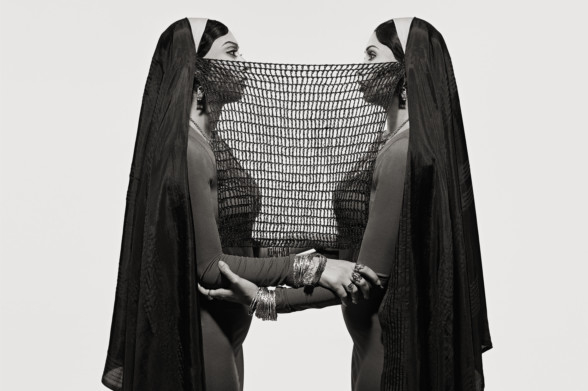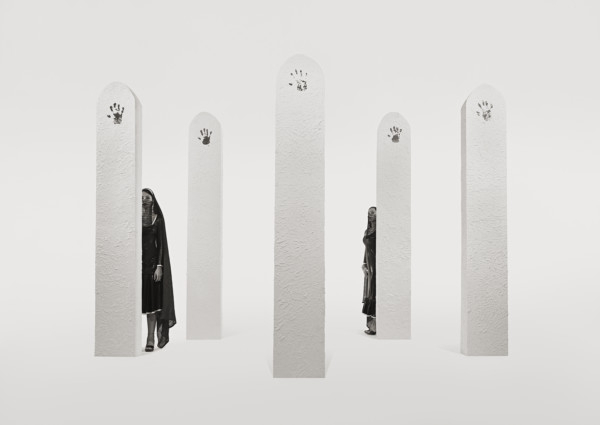
In his first solo show in Dubai, Raya and Sakina, Egyptian artist Habby Khalil has taken inspiration from a notorious criminal case in recent Egyptian history and from ancient mythology to speak about contemporary socio-political issues. The show, curated by Omar Donia features photographic works from a series titled, Sisters Without Mercy and a video. Through carefully staged scenarios the artworks explore the conflict between traditional ideologies and modern liberalism, contemplating the belief systems that shape people’s attitudes and justify wrong actions.
The title of the show refers to two sisters, Raya and Sakina who committed a series of heinous murders in Alexandria, a city that represents the liberalism and pluralism of Egyptian society. The siblings enticed women to come to their home with the promise of providing them goods at cheaper prices, and then drugged their victims, choked them to death, stole their jewellery and buried the bodies under the tiles of the house. They were sentenced to death in 1921, becoming the first women to be executed under modern Egyptian law.
Khalil’s haunting black and white photographs allude to this macabre story. They feature two similar looking women wearing black outfits, plenty of jewellery, and veils covering their faces. However, the artist has also introduced a new character in the story — a young man portrayed as a victim of the two sisters.
“The personalities of the two sisters were quite different. During the trial, Raya was silent and subdued, but Sakina bragged about her crimes and loudly proclaimed that she would commit them again. Yet their actions were similar and led to the same fate. Just as these women enticed their victims to believe their false promises, today various ideologies are trying to seduce young people by claiming to show them the right path. Though these ideologies maybe different they lead their followers to the same fate. The women in my photographs represent conservative ideologies, while the man represents contemporary young men and women who get enticed and victimised by them, embodying the eternal conflict as well as the link between different ideologies,” Khalil says.
The veiled women appear in different poses, with their intertwined hands and connected veils alluding to their linked fate. The titles of the works such as Justice for All and Follow Me speak about the false promises offered by different ideologies. An image titled Angel references historical depictions of mother and child, but with a twist. Another work, Inevitable depicts Sakina’s infant daughter, who suffered from mental illness after witnessing her mother’s crimes, and died prematurely, highlighting the inevitable consequences of wrong thinking and actions.
In some images the figures are enclosed in boxes signifying their isolation and closed minds. But the man is also shown trying to tear the thin, transparent sheet that covers his box, expressing the idea that the traditional norms that bind us and the boundaries that isolate us from society can be easily broken.
The video, titled Alienation: Bride of the Nile is the first in a series of five videos where the artist imagines ancient Egyptian deities encountering contemporary Egyptian society. This one is about Hapi, the Nile deity, and refers to the myth of the ‘bride of the Nile’ according to which a young virgin was chosen from amongst the most beautiful women in the land and thrown into the river as a sacrifice to the deity.
Symbols and gestures
In the video, the river is symbolised by an overflowing bathtub, sink and toilet in a bathroom, and a young man is seen throwing a woman into the tub. With pharaonic music playing in the background, the woman later gets up and walks away, leaving behind fish that have been displaced from the tub struggling for life on the floor. The scene is repeated continuously raising questions about the meaning and relevance of the various symbols and gestures.
“When I went abroad to study I felt like a fish out of water and began to do certain rituals that made me feel connected to my roots, but were meaningless in the context of my new environment. It took me some time to realise this and to learn to move on. This video is about such a moment in life when we realise that the things we have taken for granted, believed in and accepted as facts disappear, but the fear of losing what we considered to be the essence of our identity, and the meaning of our life, makes us cling on irrationally to those old beliefs. This work raises questions about our beliefs and how we interpret and practice them, about the meaning and purpose of our existence, and about why we go to war and kill each other for the sake of our beliefs,” Khalil says.
Jyoti Kalsi is an arts-enthusiast based in Dubai.
Raya and Sakina will run at The Empty Quarter gallery, DIFC until January 11, 2018.














